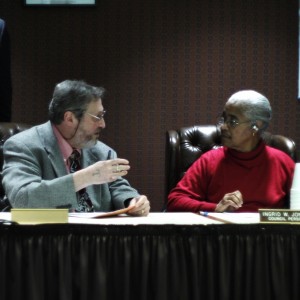Marie Lawson elected vice president while Michael O’Rourke debuts as acting city manager
By Kyle Carrozza, Staff Writer, The Times

Acting City Manager Michael O’Rourke talks with City Council member Ingrid Jones before Monday’s organizational meeting.
COATESVILLE – City Council voted Linda Lavender-Norris as 2015 council president and Marie Lawson as council vice president at Monday’s organizational meeting.
“I am a woman of faith. I believe. Therefore, I believe that we can do better and will do better,” Lavender-Norris said after taking her position.
The new officers take over for former president Joe Hamrick and former vice president David Collins, the latter of whom resigned last month.
“It’s a good positive movement because I don’t think we should have the same person every year,” said Hamrick.
Lavender-Norris, who became a councilor last year, said that she learned her duties as a council member last year and will continue to learn this year. She also acknowledged the critical situations currently facing council.
“We’ll work diligently to turn our city around for the better,” she said.
Hamrick will continue in his capacity as Coatesville’s Western Chester County Council of Governments representative, and council member Ed Simpson will serve as alternate.
Council also voted to accept Collins’s resignation.
In another administration change, Michael O’Rourke attended his first meeting as acting city manager. Council previously stated that O’Rourke will stay on until a new manager is found, a process that could take weeks or months.
O’Rourke said that his role is primarily to help the city transition from former City Manager Kirby Hudson to the next permanent manager but recognized that his input will be important for balancing the 2015 budget.
O’Rourke said that the undertaking will be difficult as municipality expenses grow, but revenue often does not. He said that he has encountered the problem in his previous work and in particular, pointed to population density as a difficulty for many urban areas. Because so much revenue depends on real estate taxes, a high population density means that the city must serve more people with a smaller tax base to draw from.






